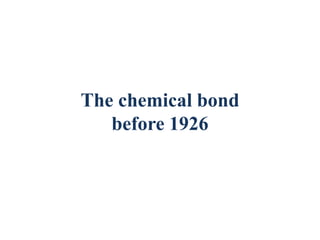
The chemical bond before 1926: Ionic and covalent bonds
- 1. The chemical bond before 1926
- 2. A chemical bond is a lasting attraction between atoms, ions or molecules that enables the formation of chemical compounds Any consideration of the structure of molecules must begin with a discussion of chemical bonds, the forces that hold atoms together in a molecule
- 3. In 1916 two kinds of chemical bond were described: the ionic bond by Walther Kossel (in Germany) and the covalent bond by G. N. Lewis (of the University of California).
- 4. Both Kossel and Lewis based their ideason the following concept of the atom. A positively charged nucleus is surrounded by electrons arranged in concentric shells or energy levels. There is a maximum number of electrons that can be accommodated in each shell: two in the first shell, eight in the second shell, eight or eighteen in the third shell, and so on. The greatest stability is reached when the outer shell is full, as in the noble gases. Both ionic and covalent bonds arise from the tendency of atoms to attain this stable configuration of electrons.
- 5. The ionic bond results from transfer of electrons, as, for example, in the formation of lithium fluoride A lithium atom has two electrons in its inner shell and one electron in its outer or valence shell; the loss of one electron would leave lithium with a full outer shell of two electrons. A fluorine atom has two electrons in its inner shell and seven electrons in its valence shell; the gain of one electron would give fluorine a full outer shell of eight.
- 6. Lithium fluoride is formed by the transfer of one electron from lithium to fluorine; lithium now bears a positive charge and fluorine bears a negative charge. The electrostatic attraction between the oppositely charged ions is called an ionic bond. Such ionic bonds are typical of the salts formed by combination of the metallic elements (electropositive elements) on the far left side of the Periodic Table with the non-metallic elements (electro¬negative elements) on the far right side.
- 7. The covalent bond results from sharing of electrons, as, for example, in the formation of the hydrogen molecule. Each hydrogen atom has a single electron; by sharing a pair of electrons, both hydrogens can complete their shells of two.
- 8. Two fluorine atoms, each with seven electrons in the valence shell, can complete their octets by sharing a pair of electrons. In a similar way we can visualize the formation of HF, H20, NH3, CH4, and CF4. Here, too, the bonding force is electrostatic attraction: this time between each electron and both nuclei.
- 9. The covalent bond is typical of the compounds of carbon; it is the bond of chief importance in the study of organic chemistry
- 10. The introduction of quantum mechanics in 1926 caused a tremendous change in ideas about how molecules are formed.
- 11. References Robert T. Morrison and Robert N. Boyd,Organic Chemistry, Sixth Edition,PageNo.3-5
- 12. THANK YOU